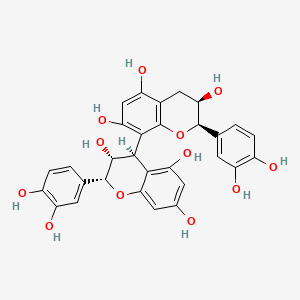| MeSH term | MeSH ID | Detail |
|---|---|---|
| Diabetes Mellitus | D003920 | 90 associated lipids |
| Diabetic Nephropathies | D003928 | 39 associated lipids |
| Body Weight | D001835 | 333 associated lipids |
| Prostatic Neoplasms | D011471 | 126 associated lipids |
Procyanidin B2
Procyanidin B2 is a lipid of Polyketides (PK) class. The involved functions are known as conjugation, Methylation, Excretory function, enzyme activity and sulfatase activity. Procyanidin b2 often locates in Blood, Epidermis and Upper Gastrointestinal Tract. The associated genes with Procyanidin B2 are NR5A2 gene, HRAS wt Allele, CFB gene, PTGS2 gene and MAPK8 gene.
Cross Reference
Introduction
To understand associated biological information of Procyanidin B2, we collected biological information of abnormalities, associated pathways, cellular/molecular locations, biological functions, related genes/proteins, lipids and common seen animal/experimental models with organized paragraphs from literatures.
What diseases are associated with Procyanidin B2?
There are no associated biomedical information in the current reference collection.
Possible diseases from mapped MeSH terms on references
We collected disease MeSH terms mapped to the references associated with Procyanidin B2
PubChem Associated disorders and diseases
What pathways are associated with Procyanidin B2
There are no associated biomedical information in the current reference collection.
PubChem Biomolecular Interactions and Pathways
Link to PubChem Biomolecular Interactions and PathwaysWhat cellular locations are associated with Procyanidin B2?
Visualization in cellular structure
Associated locations are in red color. Not associated locations are in black.
Related references are published most in these journals:
| Location | Cross reference | Weighted score | Related literatures |
|---|
What functions are associated with Procyanidin B2?
Related references are published most in these journals:
| Function | Cross reference | Weighted score | Related literatures |
|---|
What lipids are associated with Procyanidin B2?
There are no associated biomedical information in the current reference collection.
What genes are associated with Procyanidin B2?
Related references are published most in these journals:
| Gene | Cross reference | Weighted score | Related literatures |
|---|
What common seen animal models are associated with Procyanidin B2?
There are no associated biomedical information in the current reference collection.
NCBI Entrez Crosslinks
All references with Procyanidin B2
Download all related citations| Authors | Title | Published | Journal | PubMed Link |
|---|---|---|---|---|
| pmid: | ||||
| Wang JN et al. | Antioxidant activity of polyphenols from seeds of Vitis amurensis in vitro. | 2000 | Acta Pharmacol. Sin. | pmid:11360672 |
| Ottaviani JI et al. | Intake of dietary procyanidins does not contribute to the pool of circulating flavanols in humans. | 2012 | Am. J. Clin. Nutr. | pmid:22378733 |
| Gescher K et al. | Oligomeric proanthocyanidins from Rumex acetosa L. inhibit the attachment of herpes simplex virus type-1. | 2011 | Antiviral Res. | pmid:21070811 |
| Li BY et al. | Induction of lactadherin mediates the apoptosis of endothelial cells in response to advanced glycation end products and protective effects of grape seed procyanidin B2 and resveratrol. | 2011 | Apoptosis | pmid:21505870 |
| Stoupi S et al. | Procyanidin B2 catabolism by human fecal microflora: partial characterization of 'dimeric' intermediates. | 2010 | Arch. Biochem. Biophys. | pmid:20188693 |
| Wittig J et al. | Quantification of procyanidins in oral herbal medicinal products containing extracts of Crataegus species. | 2002 | Arzneimittelforschung | pmid:11878204 |
| Zhang WY et al. | Procyanidin dimer B2 [epicatechin-(4beta-8)-epicatechin] suppresses the expression of cyclooxygenase-2 in endotoxin-treated monocytic cells. | 2006 | Biochem. Biophys. Res. Commun. | pmid:16681998 |
| Wang W et al. | Procyanidin B2 ameliorates carrageenan-induced chronic nonbacterial prostatitis in rats via anti-inflammatory and activation of the Nrf2 pathway. | 2017 | Biochem. Biophys. Res. Commun. | pmid:28844677 |
| Sung NY et al. | Procyanidin dimer B2-mediated IRAK-M induction negatively regulates TLR4 signaling in macrophages. | 2013 | Biochem. Biophys. Res. Commun. | pmid:23872113 |
